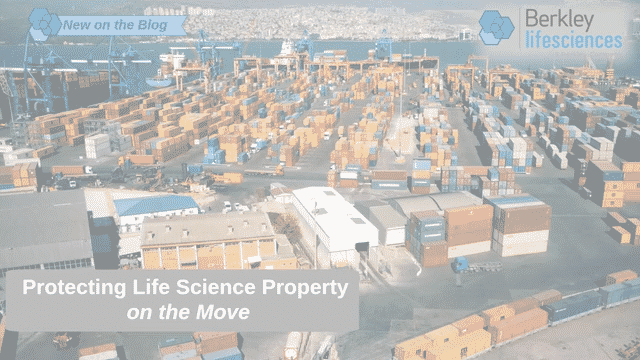Protecting Life Sciences Property on the Move

In the life sciences industry, innovation does not stop at the lab bench—it extends across the entire supply chain. As companies develop increasingly complex and sensitive products such as biologics, vaccines, and cell and gene therapies, the challenge of safely transporting these high-value assets has never been more critical. The journey from manufacturing site to end-user is fraught with risk, and even a minor disruption can result in significant financial loss, regulatory complications, and—most importantly—threats to patient safety.
Whether it is a temperature-sensitive vaccine or a one-of-a-kind clinical trial material, the consequences of transit failures can ripple across operations, delaying treatments, halting production, and damaging reputations. This article explores the most vulnerable products, the key risks they face in transit, and strategies life sciences companies can implement to protect their property while in motion.
Products Most Susceptible to Transit Risks
-
Vaccines and Biologics: Require strict cold chain logistics and are highly perishable—their complex structures degrade quickly under temperature deviations.
-
Cell and Gene Therapies: Often shipped under cryogenic conditions and are irreplaceable since they originate from the patient’s own genes or cells.
-
Clinical Trial Materials: Time-sensitive and limited in quantity, making them difficult to replace.
-
Diagnostic Kits and Reagents: Sensitive to temperature and humidity fluctuations, with short shelf lives.
Key Transit Risks for Life Sciences Property
1. Temperature Excursions
The cold chain packaging market is projected to grow nearly 15% from 2024 to 2030, driven by the rising demand for temperature sensitive products. Many life sciences products must be maintained within narrow thermal ranges—for example, many vaccines require storage temperatures between 2–8°C. Even brief deviations can compromise product integrity. The biopharma industry loses tens of billions of dollars annually due to failures in temperature-controlled logistics. Temperature excursions can result from inadequate packaging, transit delays, human error, or exposure to extreme weather. For instance, in 2017, Baxter voluntarily recalled a product batch after unintentional freezing compromised its safety and efficacy.
Best practices to reduce the risk of temperature excursions include:
-
Validated packaging.
-
Active/passive temperature controls.
-
Real-time GPS and temperature monitoring.
-
Validation of cold chain capabilities and contingency plans.
-
Conducting dry-run shipments and temperature mapping studies.
These measures and practices help ensure that each shipment has uniform and continuous climate control to prevent or mitigate excursions.
2. Theft
Prescription drug spending in the U.S. surged from approximately $30 billion in 1980 to over $330 billion by 2018, making pharmaceuticals a lucrative target for criminals. High-value pharmaceuticals are especially vulnerable during transit handoffs or storage at unsecured hubs. In 2018, nearly $1 million worth of cancer medication was stolen from a truck stop in Tennessee when the driver left the truck during a break.
To prevent similar losses, life sciences companies should:
-
Partner with carriers experienced in life sciences logistics.
-
Split high-value shipments and randomize routes.
-
Train drivers on security protocols and perform background checks.
-
Maintain communication with dispatch and law enforcement.
-
Vet rest stops and overnight parking for security protocols.
-
Share packaging lists and batch numbers with receivers to prevent counterfeit entry.
By implementing multi-layered security strategies, businesses can significantly reduce the risk of pharmaceutical theft and protect both their assets and the integrity of the supply chain.
3. Physical Damage
Improper handling, vibration, or impact during loading and unloading can damage fragile items like glass vials, diagnostic devices, or temperature-sensitive biologics. Even minor damage—such as a hairline crack in a vial—can compromise sterility and lead to costly losses. To mitigate these vulnerabilities, life sciences companies may consider:
-
Using robust, purpose-built packaging that cushions and stabilizes contents throughout the journey.
-
Implementing, and consistently enforcing standard operating procedures (SOPs) for handling, loading, and unloading.
-
Understanding their vendors’ limits of liability and service guarantees to manage risk exposure and recovery options in the event of damage.
Ultimately, safeguarding fragile pharmaceutical products requires a proactive, systems-based approach that combines physical protection, procedural discipline, and contractual clarity.
4. Delays and Route Deviations
Weather events, customs delays, or logistical errors can disrupt delivery timelines and result in business interruption or temperature excursions. For example, Hurricane Maria in 2017 severely impacted Puerto Rico’s infrastructure, halting saline production and causing widespread shortages.
It is important to review routes in advance to identify potential delays or more effective transportation alternatives. Customs clearance can also impact sensitive scientific materials, so SOPs should be established to expedite the handling of perishable goods. To further ensure the quality-of-life science products, maintain detailed records of temperature logs, chain of custody, and handling procedures.
By anticipating potential disruptions and rigorously documenting every step of the journey, businesses can help preserve product integrity, ensure regulatory compliance, and maintain continuity even in the face of unforeseen challenges.
Conclusion
Transit risk in the life sciences sector is multifaceted and constantly evolving. As the industry continues to innovate, robust, proactive risk management strategies becomes even more essential. By identifying vulnerabilities, partnering with specialized logistics providers, and implementing best practices, companies can safeguard their high-value assets and ensure operational continuity.
Ultimately, protecting life sciences property in transit is about more than preserving product integrity—it is about protecting patient health, maintaining regulatory compliance, and upholding trust. With the right approach, transportation can shift from a point of vulnerability to a pillar of resilience.
Authored by: Medora West, CHMM, CSP, MPH, Berkley Life Sciences, Senior Life Sciences, Risk Management Specialist
